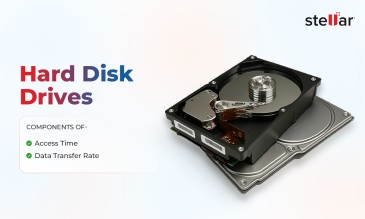Evolution of Key HDD Performance Characteristics
The storage capacity of hard disk drives has grown exponentially ever since their introduction by IBM in 1956. Simultaneously, their costs and sizes have gone down by a similar factor. Such rapid growth has been made possible due to numerous inventions and advancements in HDD technology. And these advancements have positively affected other HDD characteristics as well.
It is important to note that most users refer to capacity, cost, and size/design while comparing hard drives. However, characteristic features such as cache, data transfer speed, and access time are equally important. In this article, we will discuss how hard disk drives have evolved in terms of four key performance parameters.
1. Cache Memory Size
The first among these is cache size. Cache refers to a small, high-speed memory integrated into the PCB of the HDD. Data that is frequently needed is temporarily stored in the cache memory for faster read and write operations. In this way, the cache memory helps the HDD microcontroller minimize the time required to fetch frequently accessed data.
Early HDD models like the IBM 350 series had no dedicated cache memory—there was no need for it yet. Data retrieval relied solely on the mechanical movement of platters and read/write heads.
Soon, the need for caching grew to bridge the gap between ever-increasing processor speeds and memory access time. The breakthrough came in 1963.
- 1963: Titan (Atlas-2), one of the world’s first supercomputers, had 128K 48-bit words of main memory (equivalent to 0.75 MB).
- 1968: The term “cache” was first used in the IBM Systems journal in reference to the IBM 360 Model 85, replacing the term “high-speed buffer storage” used by engineers till then.
- 1969: IBM 360 Model 85 became the first commercially available computer with a cache. 64 KB and 128 KB variants were available.
- 1976: Split cache (L1d for data and L1i for instruction) was introduced with IBM 801.
- 1980s: Software, database systems, and, later on, internet started using caching.
- 1989: The first on-chip cache, with 8 KB memory, was built by Intel for its 80486 microprocessor.
- 1995: Intel designed the Pentium Pro, which had 16 KB L1 cache and 256 KB–1 MB L2 cache.
- 1999: IBM developed models with 32 MB cache (L2).
- 2004–2010: Cache sizes saw a substantial increase, moving into the 16 MB to 64 MB range. Examples include:
- 2003–2004: Seagate introduced Barracuda 7200.7+ and Barracuda 7200.8 with 8 MB and 16 MB cache, respectively.
- 2010: Western Digital and Seagate models featured caches up to 32 MB.
- 2011–2024: The trend toward larger caches continued, with modern HDDs boasting cache sizes ranging from 64 MB to 256 MB.
2. Access Time
Access Time refers to the time it takes an HDD's read/write head to locate and access a specific data track on the disk platter. This parameter is typically measured in milliseconds (ms) and is the sum of two components:
- Seek Time: The duration required for the read/write head to move to the correct track.
- Rotational Latency: The waiting time for the desired sector to reach the read/write head.
Faster accessing speed means that it takes the drive less time to locate and read data. For the user, this means quicker file access and application loading times.
Here is an overview of how access times have shortened over time.
- 1956–1970s: Early HDD models like the IBM 350 series had very high access times, around 600 ms.
- 1980s–1990s: Access times were reduced significantly as HDD technology matured to include multi-head designs, improved actuator mechanisms, and the use of voice coils instead of stepper motors.
- 2010s–2024: Modern HDDs have access times within the 2.5 ms to 10 ms range because of better actuator designs, increased platter density, and advanced firmware.
The following table shows this massive reduction in seek time.
| Year | Manufacturer | Model | Seek Time (ms) |
| 1956 | IBM | 350-1 | 600.0 |
| 1959 | IBM | 350-3 | 500.0 |
| 1960 | IBM | 1405-1 | 625.0 |
| 1964 | IBM | 2311-1 | 97.5 |
| 1966 | IBM | 2314 | 87.5 |
| 1970 | IBM | 3330-1 | 38.3 |
| 1974 | IBM | 3330-II | 38.3 |
| 1980 | IBM | 3380 | 24.3 |
| 1985 | Seagate | ST-225 | 73.3 |
| 1994 | Seagate | ST-12550N | 12.7 |
| 1995 | Conner | CP1275 (IDE) | 10.0 |
| 1996 | Quantum | BF2500A | 15.0 |
| 2002 | Hitachi | Travelstar 80GN | 9.5 |
| 2003 | IBM | Ultrastar 146Z10 | 6.9 |
The average access time for modern HDDs available in the market ranges between 5 ms and 10 ms. It is much shorter (~2 ms) in high-performance enterprise HDDs.
3. Rotational Speed
Rotational speed or spindle speed is the number of times the HDD's platters complete a full rotation in one minute. It is inversely related to rotational latency; that is, a faster rotational speed implies a lower latency.
Rotational speed has a direct bearing on how quickly a computer can access data stored on the platters. Higher RPM values generally translate to faster data access and improved performance.
There has been a clear trend of increasing spindle speeds from the early days of HDDs to modern high-performance drives. Below is an overview of this evolution and a table listing the major turning points:
- 1956–1970s: Early HDD models, such as the IBM 350, operated at low spindle speeds of 1,200 RPM.
- 1980s–1990s: The introduction of multi-head designs and improved actuator mechanisms led to higher spindle speeds.
- 2000s–2010s: The standard spindle speed for consumer HDDs solidified at 5,400 to 7,200 RPM.
| Year | Manufacturer | Model | Average rotational latency (ms) |
Rotational Speed (RPM) |
|---|---|---|---|---|
| 1956 | IBM | 350-1 | 25 | 1,200 |
| 1959 | IBM | 350-3 | 25 | 1,200 |
| 1985 | Seagate | ST-225 | 8.33 | 3,600 |
| 1986 | Seagate | ST-225 | 8.33 | 3,600 |
| 1994 | Seagate | ST-12550N | 4.17 | 7,200 |
| 2000 | Seagate | Elite 47GB | 5.00 | 6,000 |
| 2005 | Seagate | 400GB 7200.8 (ATA-150) | 4.17 | 7,200 |
| 2009 | Seagate | ST31000333AS 1TB 7200.11 | 4.17 | 7,200 |
| 2010 | Seagate | 1.5TB ST31500541AS | 5.08 | 5,900 |
| 2013 | Seagate | 4TB ST4000DM000 | 4.17 | 7,200 |
| 2017 | Seagate | 4TB Barracuda ST4000DM004 | 5.56 | 5,400 |
| 2019 | Seagate | 8TB ST8000DM004 | 5.56 | 5,400 |
| 2020 | Seagate | 8TB ST8000DM004 | 5.56 | 5,400 |
| 2021 | Seagate | 8TB ST8000DM004 | 5.56 | 5,400 |
| 2022 | Western Digital | 8TB WD80EAZZ | 5.32 | 5,640 |
| 2023 | Seagate | 8TB ST8000DM004 | 5.56 | 5,400 |
| 2024 | Seagate | 8TB NE-ST8000DM004 | 5.56 | 5,400 |
Note: There are HDDs with a spindle speed of 15,000 rpm (for example, Toshiba AL14SX), but they are primarily used in enterprise environments and in RAID servers.
4. Data Transfer Speed
Until early 1980s, read/write speeds of hard disks were very slow, and data transfer rates were in kilobytes per second. In the 1980s, speeds upwards of 1 MB/s were breached for the first time. By the late 1990s, HDD read/write speeds had reached 30 MB/s. By the mid-2000s, they reached 100 MB/s and have continued to rise. However, SSDs (Solid State Drives) began their ascent during this period due to their significantly faster speeds, higher durability, and lack of moving parts.
At present, commercially available HDDs for personal use have read/write speeds from 100 MB/s to 150 MB/s, while SSDs have typical speeds of 500 MB/s to 5 GB/s. This is a massive gain of almost 100,000 times from 1956, when the first hard disk drive—the IBM 350—was introduced.
Such gains are even more pronounced in features such as capacity and price per GB. A condensed, tabular representation of the degree to which HDD characteristics have improved is presented in the next section.
Scale of Improvement in HDD Characteristics Over 70 Years
Here is a summary of how significantly HDDs have improved over the decades.
| Characteristics | Started With (Year) | Improved to (Year) | Improvement |
|---|---|---|---|
| Capacity | 3.75 MB (IBM 350-1, 1956) | 32 TB (Seagate Exos M, 2025) | 9.6-million-to-one |
| Physical Volume | 68 cubic feet (IBM 350-1, 1956) | 2.1 cubic inches (2024) | 56,000-to-one |
| Weight | 2,000 pounds (IBM 350-1, 1956) | 2.2 ounces (2024) | 15,000-to-one |
| Average Access Time | ~600 ms (IBM 350-1, 1956) | 2.5–10 ms (Seagate Exos M, 2025) | ~200-to-one |
| Price per GB | $32,143 per GB (IBM 3380, 1961) | $0.031 per GB (2023) | ~1,034,645-to-one |
| Data Density | 2,000 bits/in² (1956) | 1.4 Tb/in² (2023) | ~700-million-to-one |
| Average Lifespan | ~2,000 hrs MTBF (1956) | ~2,500,000 hrs MTBF (2024) | 1,250-to-one |
In the seven decades since the advent of hard disk drive technology, features such as capacity, cache, cost, access time, data transfer speed, and form factor have improved exponentially. This has been possible because of inventions and advancements that have redefined the magnetic storage industry time and again. Some such technological strides that happened in this nearly seven-decade-long period are summarized below:
- Winchester heads: 1970s
- Thin-film heads/MR heads: Late 1980s to early 1990s
- GMR heads: Mid to late 1990s
- Perpendicular Magnetic Recording (PMR): Mid-2000s
- Helium sealing: 2010s
- Energy-Assisted Magnetic Recording & Heat-Assisted Magnetic Recording (EAMR & HAMR): 2020s
The effect of these technological strides is evident in cache size, data transfer speed, and access time. It is even more so in HDD features like storage capacity, cost, and size. Read our article on the evolution of the hard disk drive to see how exponentially the features like capacity, cost, and size have grown in the past 70 years.
About The Author

Online Marketing Expert & Content Writer












